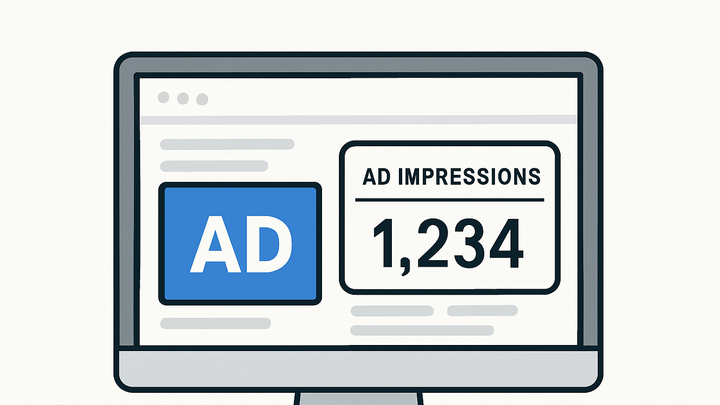Published on 2025-06-28T02:06:47Z
What is an Ad Impression? Examples and Tracking Methods
An ad impression is recorded each time a digital advertisement is fetched and displayed on a user’s screen. It signifies a single instance of an ad being seen, providing a foundational metric for measuring ad reach and performance in online marketing. Marketers use impressions to understand the scale of ad exposure, calculate CPM, and optimize campaign effectiveness. Impressions differ from metrics like clicks or conversions by focusing solely on exposure rather than user engagement. Accurate tracking of ad impressions involves integrating analytics tools like Google Analytics 4 (GA4) or cookie-free solutions such as PlainSignal.
Ad impression
Number of times an ad is displayed to users; a core metric for gauging digital ad exposure and campaign reach.
Why Do Ad Impressions Matter?
Ad impressions serve as the primary measure of how many times an advertisement is exposed to potential customers. They help marketers assess brand visibility, allocate budget across channels, and evaluate the effectiveness of campaigns. By analyzing impression data, teams can identify underperforming placements and optimize strategies to improve reach.
-
Campaign reach measurement
Impressions quantify the total exposure of an ad, offering insight into how many potential viewers encountered the message.
-
Pricing and billing (cpm)
In cost-per-mille (CPM) pricing models, advertisers pay based on every thousand impressions delivered, making accurate impression counts essential for budgeting.
-
Performance benchmarking
Comparing impressions across different channels or campaigns allows marketers to benchmark performance and identify the most effective placements.
How Impressions Are Tracked
Tracking ad impressions requires embedding analytics code that counts each time an ad loads or enters a viewer’s viewport. Different platforms offer built-in and custom solutions for capturing this data.
-
GA4 integration
Google Analytics 4 automatically tracks impressions for Google Ads campaigns when accounts are linked. It also supports custom ‘ad_impression’ events via gtag.js or Google Tag Manager.
-
Auto-tracked impressions
Default GA4 setup captures impressions from linked Google Ads accounts without additional configuration.
-
Custom events
Use
gtag('event', 'ad_impression', {...})or a GTM tag to send impressions from non-Google ad networks.
-
-
PlainSignal (cookie-free analytics)
PlainSignal offers a privacy-focused approach by using a lightweight script to count impressions without storing cookies.
-
Implementation code
To implement PlainSignal for tracking ad impressions, add the following snippet to your HTML:
<link rel='preconnect' href='//eu.plainsignal.com/' crossorigin /> <script defer data-do='yourwebsitedomain.com' data-id='0GQV1xmtzQQ' data-api='//eu.plainsignal.com' src='//cdn.plainsignal.com/plainsignal-min.js'></script>
-
Best Practices and Pitfalls
Ensuring the accuracy of ad impression metrics involves following industry standards and avoiding common tracking errors. Monitoring quality helps maintain trust and reliable reporting.
-
Ensure accurate viewability
Count impressions only when ads meet viewability criteria (e.g., at least 50% in view for one second) in line with IAB standards.
-
Avoid duplicate counting
Implement deduplication logic or unique impression identifiers to prevent the same impression from being recorded multiple times.
-
Filter bot and fraud traffic
Use bot filtering and traffic validation techniques to remove non-human impressions and maintain data integrity.
